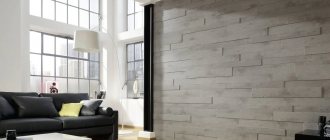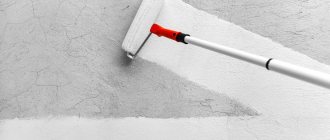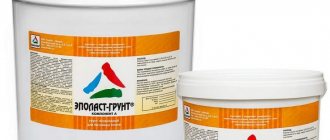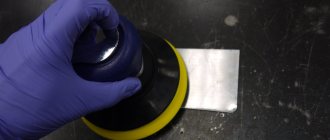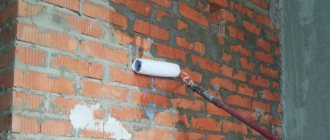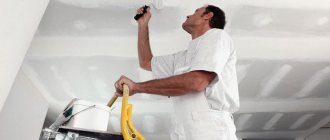Quite often, a primer is used in finishing types of work. It is needed to improve the quality of work and extend the service life of top (finish) coatings. But the choice must be made correctly, taking into account finishing materials and operating conditions. Otherwise, the use of such a coating may negatively affect the appearance and condition of the surface.
Why do you need a primer?
Primer is a dispersion of film-forming substances based on water or mineral solvents. The task of the primer composition is to improve the adhesive properties of materials. Primers also improve the properties of substrates, making them waterproof and strengthening loose surfaces. Using dispersions, you can antisepticize walls to avoid the appearance of fungus and mold in the future.
By improving the properties of the bases on which the finishing coating will be applied, the primer allows you to fully reveal all the qualities of the finishing material. This is especially true for paints. The tone and color will be fully transmitted. Priming the walls before wallpapering will reduce the consumption of adhesive.
The choice of composition for use depends on the tasks facing repair or construction work.
What is a primer (primer) and what is it for?
A primer is a special construction compound that is applied to interior and exterior surfaces, including walls, floors and ceilings. Most often, the mixture is used before plaster, paint, wallpaper, laying tiles, molding self-leveling polymer floors and other types of work are used.
Such a primer can have a varied composition, including ingredients such as:
- Resins;
- Polymers;
- Water – as a base;
- Pigments and more.
What the primer looks like depends on the composition - whether it is liquid or paste and whether it requires additional dilution with water. In addition, in some cases the composition contains dispersed substances that give some roughness to the mixture.
The main thing for which a primer is needed is the creation of a special film layer that provides an increased level of adhesion between the wall itself and the building or decorative material that will be used for finishing.
Thus, describing what a primer actually is, we can say that it is a kind of adhesive composition that forms a sufficiently deep penetration into the substrate, strengthening its mechanical properties, to provide increased strength.
A primer is a special construction compound that is applied to interior and exterior surfaces, including walls, floors and ceilings.
Types of primers
Types of primers are divided depending on the compositions on which they are made and the tasks they solve. And also on the materials for which they are used.
Based on their composition, primer mixtures are divided into:
- acrylic;
- alkyd;
- water-dispersed;
- latex;
- epoxy;
- shellac
Based on the type of effect, the compositions can be divided into:
- universal;
- adhesive;
- deep penetration;
- anti-corrosion.
Primer composition with bioprotection Source images.ru.prom.st
Depending on the surface material, soils are divided into:
- concrete – acrylic, epoxy, water-dispersed;
- plasters – acrylic, water-dispersed;
- bricks – acrylic, water-dispersed;
- drywall - acrylic, water-dispersed;
- wood – shellac;
- metal - alkyd.
Important! Remember that compounds intended for wood are absolutely not suitable for metal surfaces. And what is suitable for mineral surfaces (concrete, brick, plaster) does not apply to wooden ones.
Universal soils have average indicators for the type of impact. Each type of base has its own universal primer.
Purpose of primer material
Here's what soil is needed for:
- Strengthen the density of the base, be it a wall, ceiling or floor;
- Create a reliable adhesion between the plane itself and the coating that will be applied to it;
- Prevent the development of mold;
- Reduce the negative impact of water, temperature changes and other unfavorable operating conditions;
- Reduce material consumption - this statement is true for paints and varnishes, plasters or other building mixtures.
Another little-known point about what primer is intended for is to reduce harmful emissions from paints or other compositions. This reduces toxicity during drying and use. The metal is protected from corrosion processes. The tree is not attacked by insects.
This is the main purpose of the primer and, as can be seen from the list presented, it is better to use such a mixture to achieve high results and quality finishing work, than to then eliminate the results of negative influences. True, you need to choose the right mixture from the abundance of mixtures that are presented on the construction market.
Primer is needed to create reliable adhesion between the plane itself and the coating that will be applied to it.
Dependence of the primer on the finishing material and base
Primer, although it is a separate material, the use of one type or another depends on the finishing coating and the material of the walls.
For weak, crumbling bases, a universal deep penetration primer is used. It will help strengthen the surface, penetrating deep into the base, and a water-repellent and vapor-permeable film will form on top.
For walls in damp rooms, compositions with fungicidal (antifungal) additives are used.
Priming weak surfaces Source finitex.ru
See also: Catalog of house projects for which painting is used for decoration
In addition to special properties (waterproofness, anti-corrosion, disinfection), surface priming gives the materials additional adhesion (mutual bonding). And this is perhaps one of the main features of the soil.
The primer for walls to be painted should have the same composition as the paint. Acrylic primer will help acrylic-based water-based paint to adhere securely and evenly to the surface. The primer composition will not allow the water part of the paint to be excessively absorbed into the surface, which means that the wall will be painted evenly, without stains or smudges.
Primer for walls under plaster is applied to a brick or concrete wall. Such a composition, in addition to adhesive properties, must have antiseptic and vapor-permeable properties. In addition, priming the walls will get rid of excess dust on the surface. Under plaster mortars it is necessary to use a deeply penetrating primer for mineral surfaces.
To prime or not to prime
Many who are faced with renovation for the first time do not know why priming walls is needed and whether it is necessary to prime the walls in one case or another, so they often ignore this important stage of finishing work. But in vain! If the surface prepared for wallpapering is not treated with a primer, it will contain small roughness that can only be seen at close range. It is defects like these that cause damage to the smooth surface of the wallpaper and can ruin the appearance of the room. However, the primer can serve not only to achieve ideal leveling, but also for other purposes, on which the type and composition of the material used depends.
Is it possible to do without priming the walls? The answer to this question is ambiguous. But if you want to have a high-quality and durable repair, then priming in this case is a mandatory stage of finishing work.
When choosing a primer mixture, you first need to determine what the primer is needed for, i.e. for what tasks it will be used. Among the varieties of this material are the following:
- A strengthening option that acts as an adhesive for microparticles and is used to obtain a perfectly flat surface.
- Penetrating soil is indispensable when filling micropores.
To obtain the highest quality result, it is necessary to prime all treated surfaces and only after that paint, putty and other work.
Primer treatment has many advantages:
- allows you to obtain a high-quality and smooth surface;
- gives strength and strength to the surface;
- paint or other substance is easier to apply;
- wall defects are hidden;
- Glossy surfaces shine even more.
A high-quality wall primer will also neutralize the smell of paint and prevent the formation of mold in the future.
Applying primer to the surface
Applying priming solutions to the surface is no different from painting. Before priming the walls, the surfaces must be as clean as possible from dust and residues of plaster or putty solutions. The floor surface is protected with film from ingress of priming solutions.
You can apply the primer with a roller with a long handle Source remstroiblog.ru
The walls must be primed from below. When applying the composition from the ceiling, there is a possibility that most of the material will end up on the floor. The primer strips should overlap each other to avoid gaps and bald spots.
Apply the primer to the surface with a roller, and in corners and hard-to-reach places with a brush.
It is always necessary to cover the walls with soil in two layers. This is especially true when priming walls before painting. A carefully primed wall will allow the paint to lie flat, without spots or streaks.
Allow the first coat to dry before applying the second coat of primer.
See also: Catalog of companies that specialize in finishing materials and related services
Priming before putty: is it necessary?
Most people who want to decorate a room are wondering: do they need to prime the walls before applying putty? The answer to this question is not always clear, but it’s still better to do it. The primer significantly improves the adhesion of materials and provides protection from excess moisture.
If the surface is treated with a primer mixture in advance, the result will last significantly longer. Of course, you can skip priming, but in this case you should not count on the durability of the repair.
Soil drying time
The time it takes to carry out repairs or finishing work during construction directly depends on how long the primer dries. The period during which the applied composition dries depends on the conditions in the room. There is a direct dependence on the ambient temperature and humidity.
On average, at +20 degrees and normal humidity, drying time, depending on the type of primer, is 3 – 5 hours. However, to obtain 100% results from the priming process, it is necessary to wait 24 hours between coats. Applying the topcoat must also begin after 24 hours of exposure.
Curing of walls after priming Source blockopsgroup.co.uk
Application Tips
Applying the primer is quite simple, even a child can do it: but in order to get a high-quality result, you still need to take into account the nuances.
- First, the base must be strong, completely dry, and ready for application. That is, peeling paint cannot be primed; the old, unreliable coating must be removed.
- Secondly, prepare for the work. Dilute the concentrate (if necessary), prepare a cuvette and a roller or a jar and a brush, do not forget about a stepladder or “extension” for the roller if you are going to prime the walls or ceiling.
- Thirdly, in most cases there should be two layers. As with painting, with the second layer the surface is leveled and becomes more uniform. Wait between coats for the amount of time indicated on the bottle (usually a couple of hours), apply a second coat and leave to dry completely (12-24 hours).
- Fourth, assess external conditions. Especially if you are priming outdoors or in an unheated room. The air temperature should be 5-30 degrees, humidity - 0-75%. Do not prime in heavy rain or sub-zero temperatures!
Important! When priming metal or wood, be sure to sand the base and remove dust.
Many people consider priming an optional part of the process, but this simple, effortless step will save a lot of effort, time and nerves in the future. Don't neglect the primer if you want to achieve a truly high-quality result!
Priming walls depending on the surface
Concrete walls
For concrete bases, deep penetration acrylic primer is used. This composition allows you to increase adhesion and also eliminate minor surface roughness (scratches, chips).
Brick structures
Before priming a brick wall, you need to pay attention to the condition of the surface. If there is damage and the mortar spills out in the seams, then it is necessary to use a water-dispersed primer, which will strengthen the plane of the wall and give it adhesive properties.
You can also use mineral compounds based on cement, gypsum or lime for strengthening.
Walls made of facing bricks require treatment with water-repellent agents, which will prevent the appearance of efflorescence (white deposits) on the masonry.
Surface strengthening
A primer is also necessary to strengthen the surface. If the surface is loose, for example a gypsum partition, then it will be necessary to strengthen it with a primer, since the finish along with the loose layer can fly off from the loose surface. Completely loose layers are first removed. Strengthening the surface is carried out with deep impregnation soils or the same PVA diluted with water. The principle is similar to reducing porosity; in addition, the loose layer is slightly glued and strengthened. Completely loose layers must not be strengthened, but removed.
Surface strengthening is one of the properties of primers
Primer consumption
Material consumption is individual in each specific case. The average indicator is indicated by the manufacturer on the packaging. Each type of primer has its own average:
- acrylic – 130 – 150 g/sq.m.;
- water-dispersed – 120 g/sq.m.;
- deep penetration soil – 160 – 180 g/sq.m.
These data are valid for applying the composition in one layer. For a more correct calculation, it is necessary to measure the area of the walls and multiply by the flow rate. Then the result is increased by the number of layers. If there are many protrusions and corners in the room, then you need to add 10%.
This calculation will help determine the amount of soil and control the work crew.
Dilution of the primer mixture
Despite the fact that primer is not the most expensive construction component of a renovation, a considerable amount of it will be needed to finish one room. That is why it is necessary to dilute the soil with water, but this should be done carefully and carefully.
The amount of water used for this depends on the manufacturer and is usually indicated on the packaging. The generally accepted ratio is one part water to two parts primer. The resulting solution should be used on the same day. After some time it will deteriorate and lose its properties. It is better not to dilute the mixture applied to the plaster too much, since cement-sand mortars absorb moisture well.
Mistakes when priming walls
It’s not just those new to construction who can make mistakes when performing priming work.
The most common mistake is the use of compositions that do not match the surface and finishing materials:
- Water-based and dispersed paints cannot be used as a primer. Paints have nothing in common with primers;
- use of primers on unsuitable substrates. Alkyd primer is not used to prime plasterboard walls, and acrylic composition is not applied to metal.
Each type of surface uses its own composition Source novosibirsk.remont.firmika.ru
The second, no less popular mistake is saving the primer composition. Do not dilute water-based primers with more water than indicated in the recommendations. Priming in one layer can lead to gaps on the walls, which will worsen the properties of the soil.
Another mistake is neglecting how long it takes for the primer to dry on the walls. Drying time is necessary so that the binding part (water, solvent) evaporates and the working particles of soil remain on the surface.
Types of car coating: what kind of primer is needed?
In automobile factories, after welding a body from stamped parts, priming takes place in 7 stages, including phosphating, high-temperature drying, etc. When carrying out repair work, car enthusiasts do not use such complex industrial technologies on their own. The maximum that is available is to warm up the applied coating with a hairdryer. Ordinary household, not professional.
| Kinds | Preliminary work | Application |
| One-component. | Do not require special preparation before use. Sold in metal or plastic cans. Available in an aerosol can. | Brush or spray gun. Used for small repairs with a small area of damage. |
| Two-component primers. | Consist of polymer and hardener. The ingredients are mixed immediately before application. | They are often made from acrylic polymer or epoxy resin. This composition must be applied quickly until it hardens. |
Primers are primary and secondary. Primary ones are applied directly to ferrous metal. This is an anti-corrosion primer, it protects it from rust. Disadvantage: low adhesion.
Therefore, to increase adhesion, a layer of secondary primer - adhesive - is applied over the primary one.
Two-layer application of primer is more complex in technology than single-layer application and is more expensive.
Based on the material, primers are divided into:
- acrylic coating;
- epoxy;
- acidic.
The two-component epoxy primer is famous for its high degree of anti-corrosion protection for the machine. It is applied in order to prepare the surface for painting. It improves adhesion and fills micro-irregularities in the top layer of the body and body parts. Unfortunately, epoxy takes a long time to dry. You will have to wait more than 12 hours for complete drying. And to speed up the drying process, you cannot use a heat chamber: at elevated temperatures, the epoxy may bubble and peel off.
Acid mixtures require another coat to ensure proper adhesion. In this case, epoxy cannot be used as a secondary layer. These two types of materials react and do not provide integrity to the soil layer cake.
Briefly about the main thing
Priming the walls always precedes finishing. The question of the need to use primers disappears when quality work is of interest.
Wall primer will help repair and strengthen weak areas on the wall surface. The primer can remove minor scratches and chips. The primer composition will prepare the wall to accept any finishing material - from wallpaper to tiles. And increased adhesive properties will delay the next repair for decades.
Ratings 0
Why prime the walls before wallpapering?
During work, many do not want to spend money on additional work that does not seem to affect the process. But in fact, priming is an important step.
The composition reliably protects the surface of the walls:
- The primer forms a protective film, which increases the adhesion of other materials;
- After application, the walls become even and smooth, so the wallpaper will lie evenly and adhere well to the surface;
- The primer protects the walls from the formation of mold and mildew.
